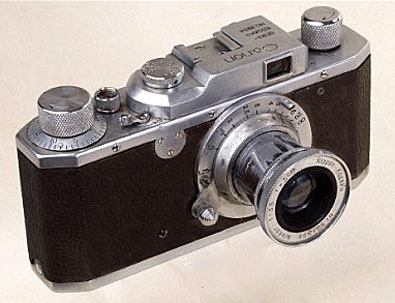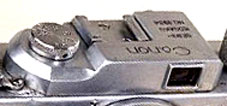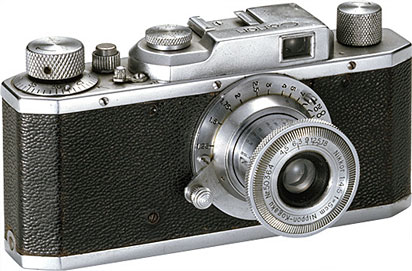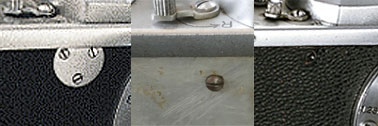Canon J Rangefinder Camera
A Description of this model produced 1939-1944

Canon J of 1940
Introduction of the Canon J in 1939
In 1939, the Seiki Kogaku - the Precision Optical Industry Co., Ltd. - 精機光学研究所 - introduced the first of its several efforts to produce a simple and more economical 35mm camera to gain wider public appeal. This was the Canon J or Canon "Junior"
Canon J Characteristics
The Canon J eliminated a slow shutter speed dial, with only a single high speed dial on the camera top. Also, the more complex rangefinder apparatus was eliminated, with only a viewfinder integrated into the camera top, rather than the pop-up finder of the Hansa Canon and the Canon S.

Canon J top with integrated viewfinder and having a rangefinder eliminated
Also, the complex and expensive Nikkor bayonet lens focusing mounting was eliminated, and the Nikkor 50mm lens was screwed directly into the camera body. Not only was this a cost savings, but Peter Dechert states:
"... it was also reactive to the fact that Nippon Kogaku could supply only a limited number of the complex focusing mounts and rangefinder units used on the Canon Hansa and S." 1
The Canon J Lens Mount
The Canon J lens mount was somewhat different from the lens mount of Leica cameras. The J mount had a diameter of 39mm, identical to Leica, but the thread pitch of the mount was slightly different. The Leica flange had a thread pitch of 26 threads per inch. The Canon J mount flange used 24 threads per inch, so its threads in the mount were slightly wider than those of the Leica mount. 4 This difference meant that Leica screw mount lenses could not easily be screwed into Canon camera bodies. This was until 1947 when Canon changed the mount in the Canon S-II which they then referred to as a "semi-universal mount" when most, but not all Leica lenses could be mounted. Then in mid-1951, Canon adopted a truly universal mount on the Canon IV and IIIA, and importantly in the widely accepted Canon IVSB. 3.
In fact, this same J mount configuration was used in both the Hansa Canon and the Canon S, since the Nikkor focusing mount screwed into the camera body using this same J mount construction. 1 However, for all these Canon rangefinder cameras, the distance from the lens to the film plain was identical to that of Leica cameras.
"First Leica Copy"
In Japan, according to Hans P. Rajner in his valuable book "Leica Copies" 5 the Canon J was considered the first Leica copy because of its strong resemblance to the Leica II. Its top structure resembled the Leica, and it used a finder in a similar Leica location, rather than the pop-up finder of the Hansa Canon and the Canon S.
Lenses with the Canon J
In keeping with the objective of offering a more economical camera model, the Canon J was sold with a Nikkor 50mm f4.5 lens. Dechert 1 states that some later Canon J models were sold with the Nikkor 50mm f3.5 lens, but this was in 1943 or 1944 when the Nikkor 50mm f4.5 lens was no longer available due to wartime conditions.

Canon J with the Nikkor 50mm f4.5 lens
Elimination of the Slow Speed Dial in the Canon J
The elimination of the slow speed dial in the Canon J models from 1939 to 1942 can be seen in three different versions. These seem to have varied depending on what camera body was available at the time of assembly. These were hand assembled from parts left over from the Hansa Canon and the Canon S to make the simplified Canon J.
Some versions attached a metal plate over the body cover to hide the hole of the missing slow speed mechanism. It seems more frequent that the body cover was simply attached over top of the slow speed hole. And in some late versions, a body with no hole was used to construct the Canon J camera. These three versions are shown below.

Left to right, Canon J with metal plate cover, body with no slow speed hole, body with camera cover glued over the slow speed hole.
Production of the Canon J
Peter Dechert 1 estimated that about 200 cameras of the Canon J were produced from January 1939 until 1943 or perhaps from left-over parts in 1944.
You can click on the links in the table below to consult other pages of the canonrangfinder.org site.
| Navigation: Click Below to Jump to Desired Subject Page | ||
|---|---|---|
| Canon Rangefinder Cameras - 1 | Canon Rangefinder Cameras - 2 | Canon Rangefinder Lenses |
| Canon S | Canon IVSB2 | Canon 19mm |
| Canon J | Canon IIS2, IID2, IIF2 | Canon 25mm |
| Canon NS | Canon VT, Canon L2 | Canon 28mm |
| Canon JS | Canon L1, L3 | Canon 35mm |
| Canon J-II | Canon VT Deluxe | Nikkor 50mm |
| Canon S-II | Canon VL, VL2 | Canon 50mm |
| Canon IIB | Canon VI-L, VI-T | Canon 85mm |
| Canon III, IIC, IV | Canon P | Canon 100mm |
| Canon IIIA, IVF, IVS | Canon 7 | Canon 135mm |
| Canon IIA, IID, IID1 | Canon 7s | Canon 200mm-1000mm |
| Canon IVSB | Minolta Rangefinders | Minolta Lenses |
| Canon IIF, IIS | Other Rangefinders | other M39 lenses |
| Go to canonrangefinder.com home page | ||
Any additions or corrections to these pages would be welcome simply by contacting this site as shown at the foot of this page .
Footnotes:
1 Dechert, Peter. Canon Rangefinder Cameras 1933-1968. Hove Collectors Books. West Sussex, United Kingdom. 1985. ISBN 0-906447-30-5.
Peter Dechert's book is the most important expert source of information regarding Canon Rangefinder Cameras.
2 Kitchingman, Peter. Canon M39 Rangefinder Lenses 1939-1971. A Collector's Guide. Published by Peter Kitchingman. Perth, Australia. 2008. ISBN 978-0-646-48144-9.
Peter Kitchingman's book is the definitive study of the more than three decades of M39 format camera lenses developed for Canon Rangefinder Cameras.
3 Nostalgic Canon Camera Book. 懐かしいキヤノン EI Publishing Co. Ltd. Tokyo, Japan. June 2003.
Peter Kitchingman's book is the definitive study of the more than three decades of M39 format camera lenses developed for Canon Rangefinder Cameras.
4 "Canon Camera Museum" history website. https://global.canon/en/c-museum/history/ published by Canon, Inc. accessed in 2019.
5 Rajner, Hans P. (author), John Wade (editor). Leica Copies. Classic Collections Publications. London, UK. ISBN 13: 9781874485056
Hans P. Rajner's book is an excellently detailed and carefully researched study of camera from around the world which used the Leica M39 lens mount and the same lens to film plane distance.
7 Dechert, Peter. Canon Single Lens Reflex Cameras 1959-1991. Historical Camera Publications. Yakima, Washington. 1992. ISBN 1-879561-04-2.
8 Tomlinson, Shawn M. The Film Photography Book. Lulu Pulbications. 2016. ISBN: 9781365263972
9 Sartorius., Ghester. Identifying Leica Lenses. Classic Camera 19. Tokyo, Japan. 2001. ISBN 4-257-12029-0
10 website http://www.nicovandijk.net/rflensmatrix.htm consulted 2019.
11 O'Reagan, Douglas M. Allied Exploitation of German Science after World War II. Johns Hopkins University Press. Baltimore, Maryland. 2019. ISBN 9781421428888
12 website www.canonrangefinder.servehttp.com consulted 2008.
13 Minolta expert Andrea Aprà has posted information on minoltarangefinders group and other groups and further detailed information by email. (thanks Andrea !)
14 website http://www.collection-appareils.fr/objectifs/ consulted 2019.
15 Small, Marc James. Non-Leitz Leica Thread-Mount Lenses. Wittig Books. Hückelhoven, Germany. 1997. ISBN 3-930359-47-2.
16 the Nikon Corporation website: https://imaging.nikon.com/history/ consulted 2019.
17 p 152. Ray, Sidney F. Photographic Lens ISBN 9780240510323
18 website http://www.rokkorfiles.com/Lens%20History.html accessed 2019
If you have any comments or questions about this Canon Rangefinder site, please e-mail me (Larry Huffman) at e-mail address: [email protected]